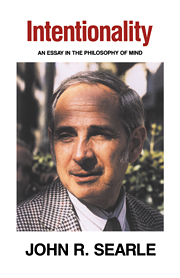Book contents
- Frontmatter
- Contents
- Acknowledgements
- Introduction
- 1 The nature of Intentional states
- 2 The Intentionality of perception
- 3 Intention and action
- 4 Intentional causation
- 5 The Background
- 6 Meaning
- 7 Intensional reports of Intentional states and speech acts
- 8 Are meanings in the head?
- 9 Proper names and Intentionality
- 10 Epilogue: Intentionality and the brain
- Subject index
- Name index
9 - Proper names and Intentionality
Published online by Cambridge University Press: 05 June 2012
- Frontmatter
- Contents
- Acknowledgements
- Introduction
- 1 The nature of Intentional states
- 2 The Intentionality of perception
- 3 Intention and action
- 4 Intentional causation
- 5 The Background
- 6 Meaning
- 7 Intensional reports of Intentional states and speech acts
- 8 Are meanings in the head?
- 9 Proper names and Intentionality
- 10 Epilogue: Intentionality and the brain
- Subject index
- Name index
Summary
THE NATURE OF THE PROBLEM
The problem of proper names ought to be easy, and at one level I think it is: we need to make repeated references to the same object, even when the object is not present, and so we give the object a name. Henceforward this name is used to refer to that object. However, puzzles arise when we reflect on the following sorts of considerations: objects are not given to us prior to our system of representation; what counts as one object or the same object is a function of how we divide up the world. The word does not come to us already divided up into objects; we have to divide it; and how we divide it is up to our system of representation, and in that sense is up to us, even though the system is biologically, culturally, and linguistically shaped. Furthermore, in order that someone can give a name to a certain object or know that a name is the name of that object, he has to have some other representation of that object independently of just having the name.
For the purposes of this study we need to explain how the use of proper names fits in with our general account of Intentionality. Both definite descriptions and indexicals serve to express at least a certain chunk of Intentional content.
- Type
- Chapter
- Information
- IntentionalityAn Essay in the Philosophy of Mind, pp. 231 - 261Publisher: Cambridge University PressPrint publication year: 1983
- 1
- Cited by



